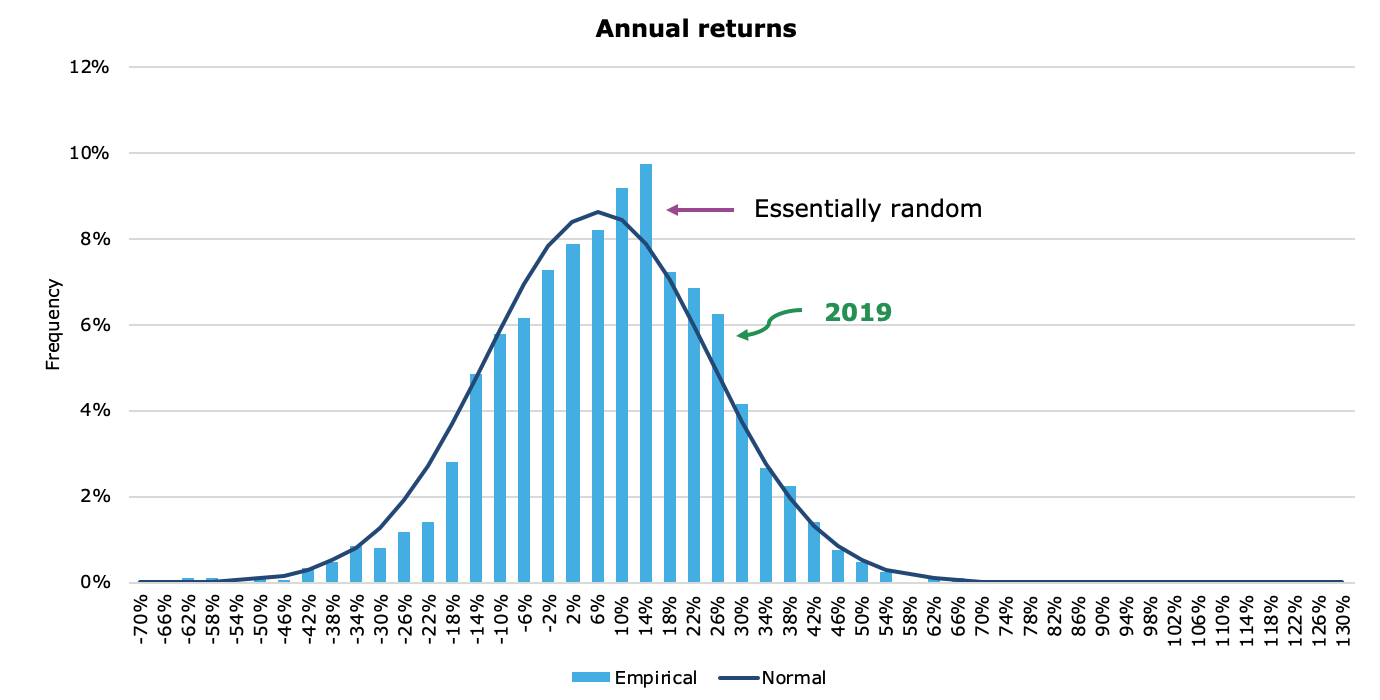What Distribution Best Describes Stock Returns
1 market risk 2 the outperformance of small-cap companies Small Cap Stock A small cap stock is a stock of a publicly traded company whose market capitalization ranges from 300 million to approximately 2 billion. The DRS should be viewed as a long-term strategic solution and one that we believe has the best chance of helping investors stay invested and reach their goals over time.

The Distribution Of Stock Market Returns
Which one of the following best describes the probability that this stock will lose at least half of its value in any one given year.

. List everything you know about the conditions. The message for investors is. The mean return d.
Return A less than 16 percent B less than 5 percent C less than 10 percent D less than 25 percent E less than 50 percent will be-50 percent returns of 113 percent 98 percent-73 percent and. A stocks returns have the following distribution. Leptokurtic is a statistical distribution where the points along the X-axis are clustered resulting in a higher peak or higher kurtosis than the curvature found in a normal distribution.
In fact because stock prices are bounded by zero but offer a potentially unlimited upside the distribution of stock returns has been described as log. In finance the concept of skewness is utilized in the analysis of the distribution of the returns on investments Return on Investment ROI Return on Investment ROI is a performance measure used to evaluate the returns of an investment or compare efficiency of different investments. Although many finance theories and models assume that the returns of securities follow a.
The Fama-French model aims to describe stock returns through three factors. A stock has an expected rate of return of 13 percent and a standard deviation of 21 percent. Stock As CV is.
Calculate the stocks expected return standard deviation and coefficient of variation. Which of the following are needed to describe the distribution of stock returns. Steps provide another process for selecting probability distributions that best describe the uncertain variables in your spreadsheets.
The higher the expected rate of return the wider the distribution of returns. In the old literature on this issue the popular alternatives to the normal distributions were non-normal symmetric stable distributions which are fat-tailed relative to the normal and t-distributions with low degrees of freedom which are also fat-tailed. The standard deviation of returns.
Why returns have a stable distribution. Calculate the coefficient of variation CV of each stock and determine if Stock A has less dispersion or more dispersion relative to B. Expect extreme returns negative as well as positive.
As A tale of two returns points out the log return of a long period of time is the sum of the log returns of the shorter periods within the long period. Thus a return of 25 percent or more has less than a 25 percent chance of occurring in any one year. A financial modeling tutorial on how to create an Excel frequency distribution table and histogram in Excel using stock returns to aid in portfolio managemen.
Expected returnRespective returnRespective probability 01-3001-14031103200 View the full answer Transcribed image text. Returns of all the stocks listed on the NYSE. The log return over an hour is the sum of the minute log returns within the hour.
How is the expected return on the stock computed. The variety of returns c. Stock B has a mean annual return of 20 and a standard deviation of 30.
In one year its price rises to 114 and it pays a dividend of 1. The standard deviation of returns. A stock has an expected rate of return of 13 percent and a standard deviation of 21 percent.
You buy a stock for 100. Total return divided by N - 1 where N equals the number of individual returns. Which one of the following best describes the probability that this stock will lose more than 45 percent in any one given year.
The value of a non-normal distribution of returns Moreover as an investment strategy the Defined Risk Strategy was meant to be a manifestation of these principles. The normal distribution is the most common type of distribution assumed in technical stock market analysis and in other types of statistical analyses. To select the correct probability distribution use the following steps.
Relative to large-cap companies and 3 the outperformance of high book-to-market. A stock has an expected rate of return of 79 percent and a standard deviation of 62 percent. The mean return d.
An investor is considering two investments. The life span of the stock b. Which one of the following best describes an arithmetic average return.
A stock has a beta of 12 the market rate of return is 113 percent and the risk-free rate is 42 percent. Which one of the following best describes the probability that this stock will lose at least half of its value in any one given year. The log return over a year is the sum of the daily log returns in the year.
Stock A has a mean annual return of 16 and a standard deviation of 14. ER 0042 120113 - 0042. Look at the variable in question.

Are Stock Returns Normally Distributed By Tony Yiu Towards Data Science

No comments for "What Distribution Best Describes Stock Returns"
Post a Comment